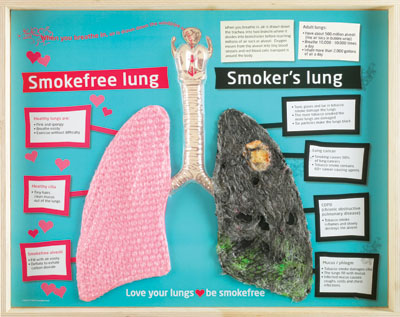Each third Thursday of November, the American Cancer Society (ACS) presents the Great American Smokeout to encourage the 42 million Americans who still smoke cigarettes to kick their habits in the butts. Besides clearing the air with non-smokers, the biggest benefits for users to stop smoking are health-related. Kicking cigarettes to the curb reduces their risk of many types of cancers, as well as decreases the chance of heart attack, stroke and chronic lung disease. Quitting smoking also increases the success of treatment for already diagnosed health problems like cancer.
This is critical when you consider that approximately 80 percent of deaths from COPD (Chronic Obstructive Pulmonary Disease) are a result of smoking. Of the more than 7,000 chemicals in tobacco smoke, at least 60 are known carcinogens. Lung cancer is the leading cause of cancer deaths among men and women in the United States, and smoking causes approximately nine out of 10 cases of lung cancer.
Smoking also slows down lung growth in children and teens, With a third of the nation’s youth estimated to eventually die prematurely from smoking-caused diseases, this roughly equates to 6 million young people alive right now—76,000 of whom are currently living in my home state, according to the Connecticut Department of Public Health. Here, smoking is the number one cause of heart disease, which is the top cause of death in the state.
The health threat of tobacco smoke isn’t limited to smokers alone. Secondhand smoke can cause disease and premature death in nonsmoking children and adults. Secondhand smoke can cause severe asthma in children, as well as lead to pneumonia, bronchitis and an increased risk of SIDS. Exposure to secondhand smoke is thought to increase the risk of heart disease by as much as 30 percent and cause roughly 46,000 deaths from heart disease each year in the United States .
Fortunately, you’re never too old–or too young–to quit smoking. Studies have shown that smokers who quit around the age of 50 reduce their risk of dying prematurely by 50 percent compared to those who keep smoking. Those who quit at age 30 reduce their risk of early death from smoke-related disease by more than 80 percent.
The ACS states that within 12 hours of refraining from lighting up, smokers experience the level of carbon monoxide in their blood returning to normal and the abnormally high heart rate and blood pressure in smokers drops. Circulation can improve in within a few weeks, and coughing and wheezing is reduced. Within several months of quitting, people also experience significant improvements in lung function.
Even we non-smokers know that quitting isn’t easy. There are a number of tools and resources out there to help. It’s important to remember that what works for one person may not work for you—if you can’t quit cold turkey, consider gradually cutting back on the amount you smoke. For some people, the decision to quit is for health reasons; for others, motivation comes from setting a good example for their kids.
My mother was a smoker before I was born, and her children implored her to quit. She shared how important it was to have a detailed plan in place before she made the date to stop smoking. She first visualized what her life would be like as a non-smoker. She would stop going outside with co-workers during work breaks when everyone was smoking, and she decided she would walk during that time instead. She had a steady supply of crunchy carrot and celery sticks at her desk to combat the craving to have the physical sensation of a cigarette in her mouth. With her plans firmly in place, she was able to quit cold turkey.
It’s also crucial to set up the right supports. Surround yourself with people who will cheer your mission to quit. Find a buddy you can text or call whenever you have a craving to smoke, who will help remind you of why you really don’t want to pick up that next cigarette.


An excellent article with clear workable suggestions. Shirley Amy BSc., author “The Winning Way to Quit Smoking”
Thank you so much, Shirley Amy! I’ll have to look up your book.